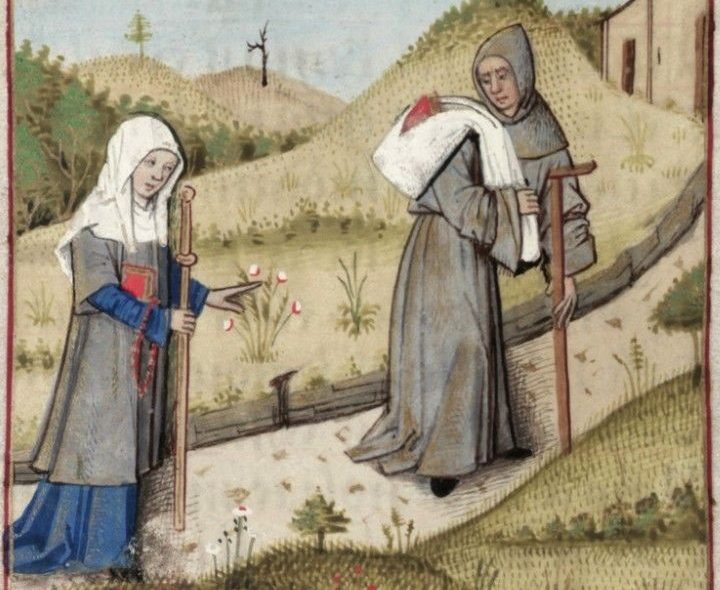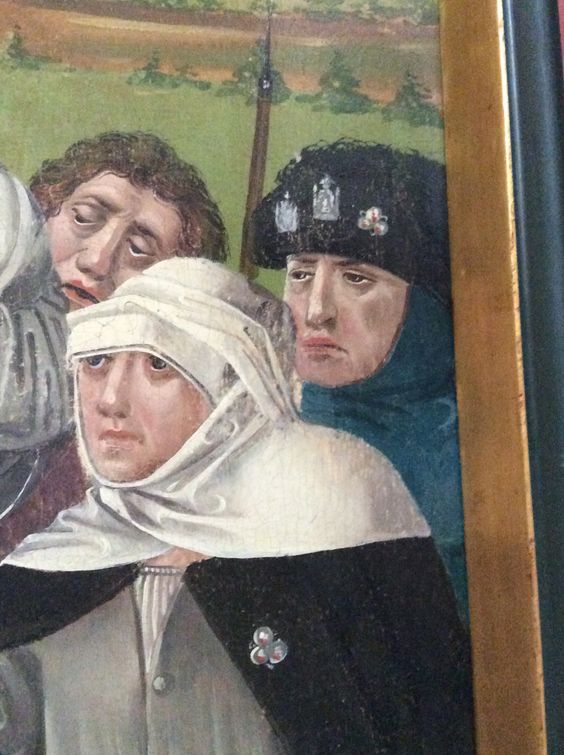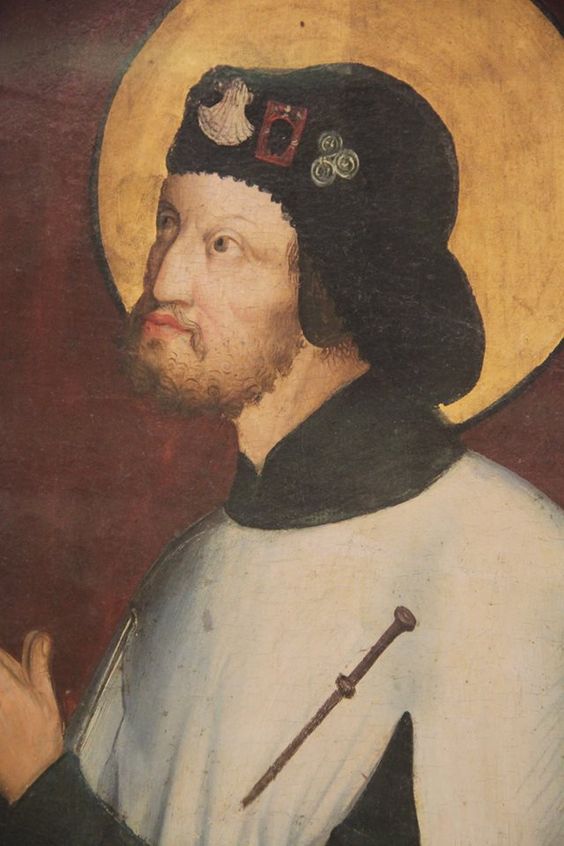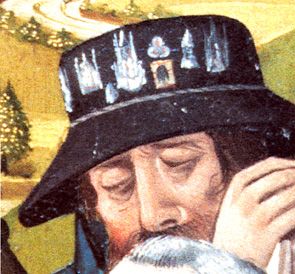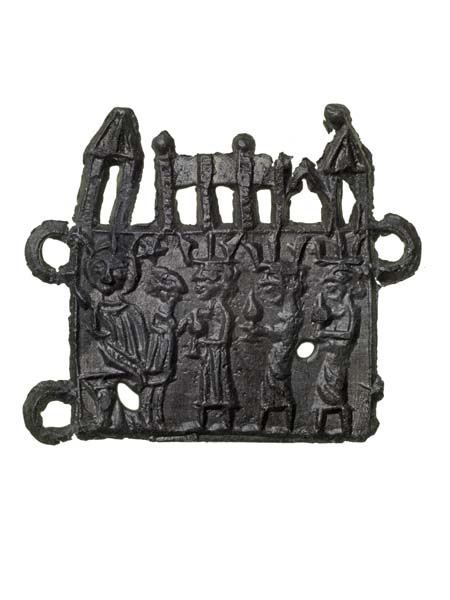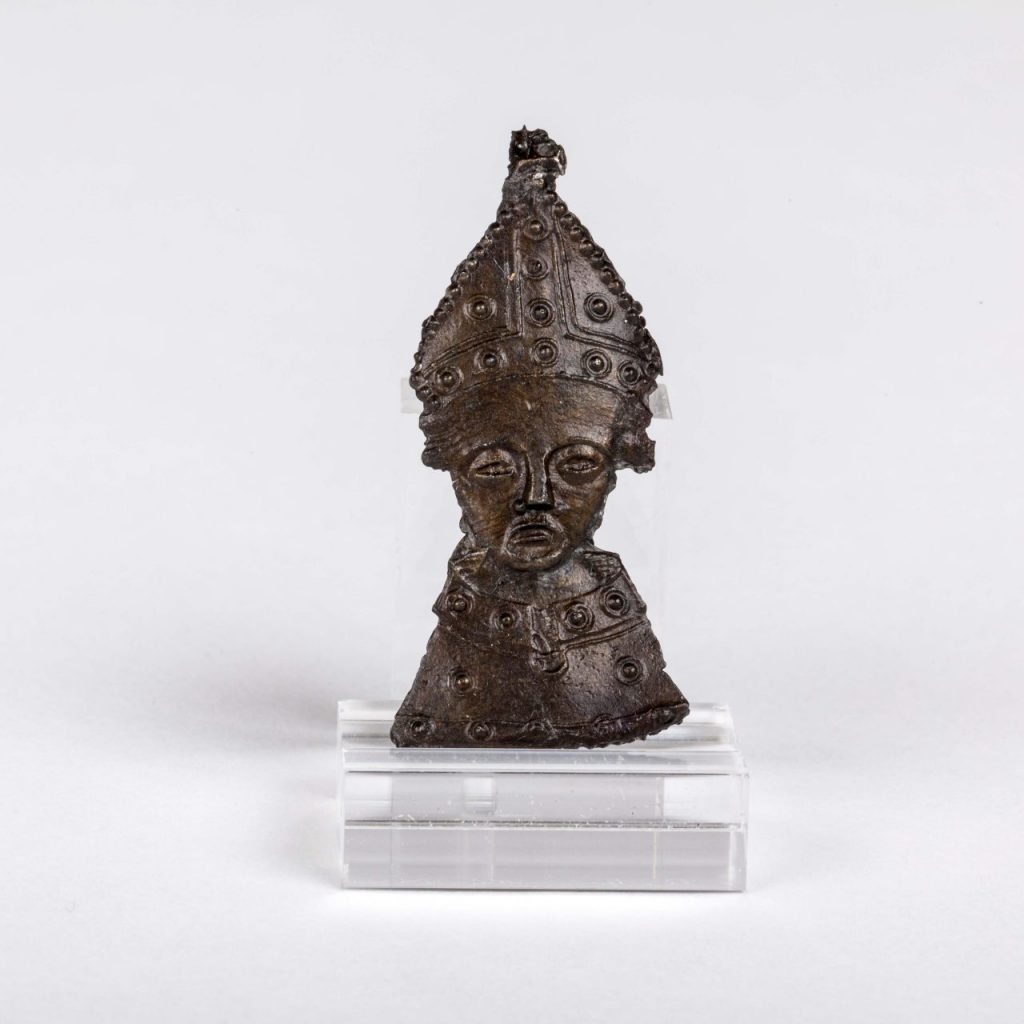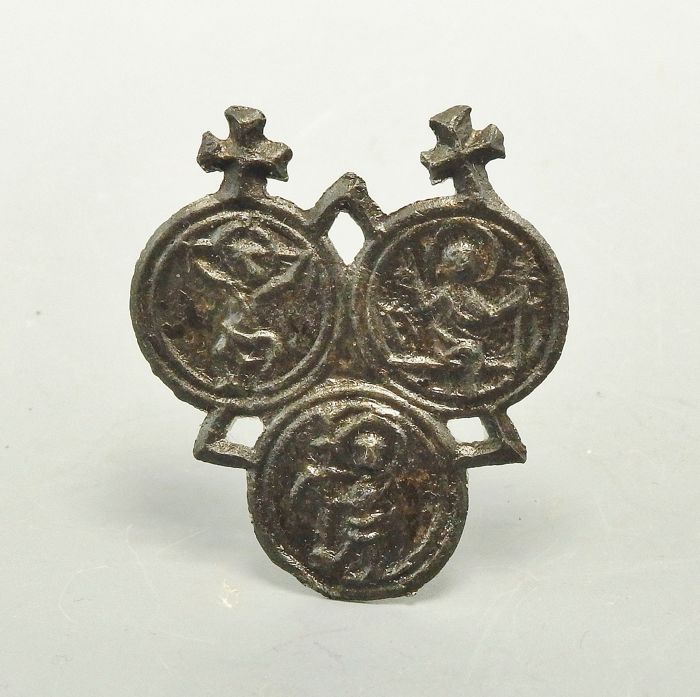Medieval people are often portrayed as staying in the same place their whole life. While some people did not travel extensively, others did – sailors, kings, some members of the clergy and… pilgrims.
The pilgrimage was quite a common occurrence in the middle ages. That doesn’t mean that everyone had been on a pilgrimage, or that everyone knew someone who had, but the pilgrim as a concept and archetype was well known.
In this short article I want to summarize what you can bring with you and wear if you want to portray a medieval pilgrim. The focus will be on the early period, before 1330, but I might include some pictures of later pilgrims, but I think the late medieval pilgrim is easier to find reliable sources to portray. So let us dive into equipment.
The Staff
The most iconic part of the pilgrim’s attire is arguably the staff. There seems to be a progression where in the early period, in the 13th century, the staff is basically just a stick with a ball on top of it. As time progresses, say late 13th century to early 14th century we see the classic pilgrim’s staff with two balls, and from the 14th century onwards we occasionally see three balls on the staffs. In some instances the staff is just a plain stick, but that is the exception. The one ball version seems to continue at least into the 15th century in some pictures, but by then the two or three balled versions are much more popular, sometimes equipped with a metal hook to hang things from as well. Staffs could often be equipped with a little spike at the bottom to give extra grip and perhaps, in an emergency, function as a makeshift spear.

Bible Moralisée, Cod. 2554
HAN MAG,
1225-1249
Pfarrkirche von Leibling, 1335 
Bib. Ste. Genevieve MS.1130 Pèlerinage de vie humaine, 033v, 1375 – 1399 
Alleged 13th century find of pilgrim’s staff 
Ferrule or collet, Medieval, Helsingborg, Sweden
Scrip / Bag
Next up is the scrip or bag. Carrying some small things can be essential when
you are travelling even though we tend to carry a lot more than the average
medieval person (keys, wallet, phone). Scrips show a great deal of variation
when it comes to design. Common to basically all of them is that they have a
lid. Apart from that they can be interpreted as being made of varying materials
(linen canvas, woollen cloth, leather). The lid can be closed with buttons or
toggles or just hanging freely. Sometimes it has tassels. Very often the
pilgrim’s scrip will feature the scallop from Santiago de Compostela, but quite
a few scrips sport crosses instead. Maybe the cross is there on the way to Santiago,
and then you replace it with the scallop once you’ve reached your goal? I don’t
really know. Quite a few have nothing at all attached to them. Towards the end
of the medieval period they seem to be getting bigger. Popular colours for them
are black and white, occasionally brown or blue, and sometimes red and other
colours. Sometimes they seem to be embroidered.

The Casket of Saint Elisabeth, Marburg, after 1235 
Lausanne, Bibliothèque cantonale et universitaire – Lausanne, U 964, Biblia Porta, f 172v, ca 1300 
Pilgrims from the Maciejowski Bible 
Add MS 42130, f. 32r, Luttrell Psalter, 1325 – 40 
Unknown source, France or Spain(?)
Hat
Even though there were inns and pubs along all major roads pilgrims could be expected to be out in rough weather. A hat is a good thing to have when the rain is pouring down. Later in the medieval period pilgrims often sported a brimmed hat with the brim turned up, but in the early period the most common was a rather shallow and broad brimmed hat, kind of resembling a salad bowl, that was just left the way it was. Alternatives could be a bycocket or just what we today would refer to as an ordinary “hat”. The broad brimmed version could evidently be worn by both men and women. They are often shown as undecorated, but sometimes a scallop, or even a few scallops, can be seen attached to it. I have yet to see any early period examples of pilgrims’ badges sewn onto the hat, but it is entirely possible. We know it was being done later in the medieval period.

Frescos from the refectori Seu Vella Lleida, 1330 
Paris – Bibl. Mazarine – ms. 0018, f. 285, Bible, ca 1220 – 1230 
Les Grandes chroniques de France 1332-1350 Royal MS 16 G VI Folio 165r 
Paris – Bibl. Mazarine – ms. 0030, f.357v, part of Bible, 1280 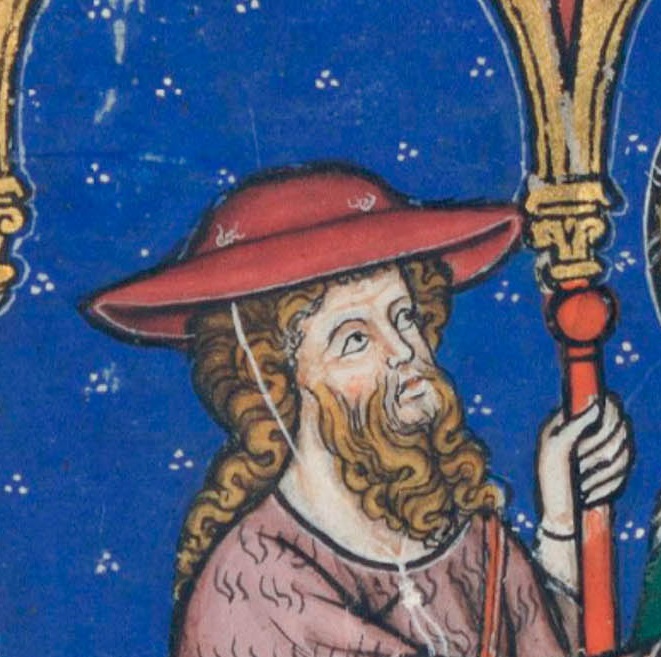
Livre d’images de Madame Marie, NAF 16251
Images de la vie du Christ et des saints, f. 46r, 1285
Outerwear
Pilgrims can be seen in a lot of different clothing, but they are most often seen in different kinds of medieval surcotes, resembling what is today referred to a “gardecorps”. Very often these surcotes have semi-circular sleeves, and these are seen on female pilgrims too. Sometimes they seem to wear cloaks, but the clothing used is very varied.

Livre d’images de Madame Marie, NAF 16251, 1285, Nouvelle acquisition française 16251, fol. 66 recto 
c 1295, La Somme le Roi, f. 136v 
Life of St Edward the Confessor (MS Ee.3.59) , 1250 – 60 
Bible historiale
France, Paris, ca. 1325
MS M.323 II, fol. 275r
1320s, England; BL Stowe 12, f.279v
Footwear
Some of the pilgrims appear to be barefoot, some are wearing low shoes and some are wearing boots. Again, there is no uniformity.
Costrel
A costrel for water is good to have around, either in pottery, leather, a wooden one or, later in the medieval period or possibly earlier in the south, a gourd.

Zillis, St Martin. Painted ceiling, detail panel «The flight into Egypt», ca 1140-60 
E 36/284,
Abbreviatio (abridgement) of Domesday Book, possibly compiled around 1241 in the scriptorium of Westminster abbey.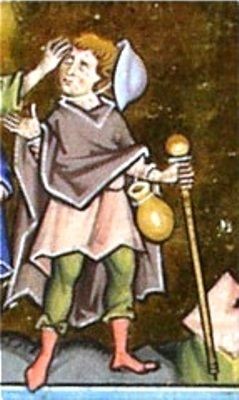
Mainzer Evangeliar, ca. 1250, Hofbibliothek Aschaffenburg, MS 13. bilde 52.
Extra bag
And extra bag for carrying stuff is occasionally seen, sometimes carried casually on the staff.

Weltchronik – BSB Cgm 6406, Bistum Passau, around 1300 , «bildnummer 213» 
Vita et miraculae sancti Benedicti
Austria, St. Florian, early 14th century
MS M.55 fol. 3v
The Martebo Maid, Gotland, Sweden, 1300 – 1350
Pilgrim badges and ampullae
So. Now that you have all your gear you depart on your journey. If you’re going to Nidaros you might walk or ride north, or if you’re going to Santiago de Compostela or Rome you might take a ship south to Brygge. Anyway your prize awaits you: salvation, less time in Purgatory, your sins forgiven… but also some very stylish pewter badges. But where to put them? We know that pewter badges and other pilgrim souvenirs were big business but we rarely see them displayed until quite late (14th/15th century). But they must have been worn somehow, and my best guess is that they were sewn to the hat or the scrip.
Interestingly enough some of the later depictions do show actually identifiable pilgrim badges from known sites.
Conclusion
There are several attributes associated with pilgrims in early depictions, i.e. before ca 1350. Some of them are very iconic, but that does not mean that they necessarily have to be present all at once. Very rarely does a pilgrim display all of said attributes. My theory is of course that not all items are needed, not all pilgrims did need that extra bag, but also because not all items are needed in art to show that this is a pilgrim (which is often the point). Some of the late medieval depictions though are clearly meant to show actual pilgrims, and those are, because they are done in a later more naturalistic style of art, but also most probably because they are meant to be showing real people in the present and not allegorical pilgrims from the Bible, closer to the real world medieval pilgrim.
My hope is that this little article will have been helpful when it comes to reenacting pilgrims of the 13th and early 14th century, and to be of guidance to those who are considering going on a pilgrimage. Safe travels!
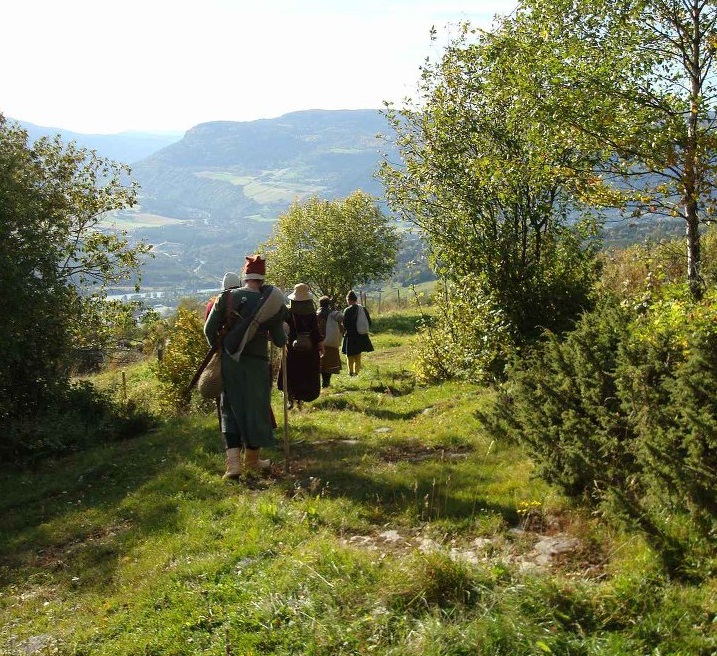
Oh, and the first pic at the top of the page… is from Le Roman de la Rose, Bodleian Library MS. Douce 195, fol 086v. Late 15th century.

